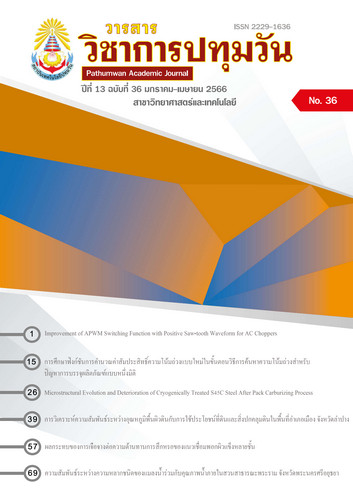ผลกระทบของการเจือจางต่อความต้านทานการสึกหรอของแนวเชื่อมพอกผิวแข็งหลายชั้น
Main Article Content
บทคัดย่อ
งานวิจัยนี้มีวัตถุประสงค์เพื่อศึกษาผลกระทบของการเจือจางต่อความต้านทานการสึกหรอของแนวเชื่อมพอกผิวแข็งหลายชั้นบนเหล็กกล้าคาร์บอนเกรด AISI 1045 ด้วยกระบวนการเชื่อมอาร์กโลหะแก๊สคลุมโดยการวิเคราะห์แบ่งออกเป็น 2 ส่วน ส่วนแรกเป็นการตรวจสอบความสมบูรณ์ของเนื้อเชื่อม (Sound welds) สัดส่วนการเจือจางและส่วนผสมทางเคมีในเนื้อเชื่อมของชั้นพอกผิวแข็ง ส่วนที่สองเป็นการทดสอบสมบัติทางกลประกอบด้วยค่าความแข็งความต้านทานการสึกหรอ ผลการทดลองสามารถสรุปได้ดังนี้ในการเชื่อมซ่อมพอกผิวแข็งด้วยการอาร์กโลหะแก๊สคลุมควรเชื่อมเพียงชั้นเดียวซึ่งให้อัตราการเจือจางต่ำและพบว่าการเชื่อมหลายชั้นส่งผลต่อจำนวนปริมาณธาตุโครเมียมและซิลิคอนในเนื้อเชื่อมพอกผิวแข็งมีแนวโน้มลดลงและทำให้มีความต้านทานการสึกหรอลดลง
Article Details

This work is licensed under a Creative Commons Attribution-NonCommercial-NoDerivatives 4.0 International License.
เนื้อหาและข้อมูลในบทความที่ลงตีพิมพ์ใน Journal of Advanced Development in Engineering and Science ถือเป็นข้อคิดเห็นและความรับผิดชอบของผู้เขียนบทความโดยตรง ซึ่งกองบรรณาธิการวารสารไม่จำเป็นต้องเห็นด้วยหรือร่วมรับผิดชอบใดๆ
บทความ ข้อมูล เนื้อหา ฯลฯ ที่ได้รับการตีพิมพ์ในJournal of Advanced Development in Engineering and Science ถือเป็นลิขสิทธิ์ของ Journal of Advanced Development in Engineering and Science หากบุคคลหรือหน่วยงานใดต้องการนำทั้งหมดหรือส่วนหนึ่งส่วนใดไปเผยแพร่ต่อหรือเพื่อกระทำการใดๆ จะต้องได้รับอนุญาตเป็นลายลักษณ์อักษรจาก Journal of Advanced Development in Engineering and Scienceก่อนเท่านั้น
References
Chindaprasirt, P. & Jaturapitakkul, C. (2005). Cement and applications. Bangkok: Siam Cement Group.
Chakraborty, G., et al. (2014). Study on microstructure and wear properties of different nickel base hardfacing alloys deposited on austenitic stainless steel. Surface and Coatings Technology, 244, 180-188.
Gualco, A., et al. (2015). Wear Resistance of Fe-based Nanostructured Hardfacing. Procedia Materials Science, 8, 934-943.
Cabrol, E., et al. (2015). Plastic strain of cobalt-based hardfacings under friction loading. Wear, 330-331, 354-363.
Abed, H., et al. (2018). Characterization of Fe49Cr18Mo7B16C4Nb6 high-entropy hardfacing layers produced by gas tungsten arc welding (GTAW) process. Surface and Coatings Technology, 352, 360-369.
Rodríguez Ripoll, M., et al. (2016). The role of niobium in improving toughness and corrosion resistance of high speed steel laser hardfacings. Materials & Design, 99, 509-520.
Zahiri, R., et al. (2014). Hardfacing using ferro-alloy powder mixtures by submerged arc welding. Surface and Coatings Technology, 260, 220-229.
Srikarun, B., et al. (2019). The effects of dilution and choice of added powder on hardfacing deposited by submerged arc welding. Wear, 424-425, 246-254.
Kimapong, K., et al. (2016). Microstructure and Wear Resistance of Hard-Facing Weld Metal on JIS-S50C Carbon Steel in Agricultural Machine Parts. Materials Science Forum, 872, 55-61.
Lertvijitpun, M. (2005). Using Carbon Equivalent Prediction of HAZ Hardness in Welds of HSLA Steels. The Journal of Industrial Technology, 1(1), 60-65.
Bramfitt, B. L., & Benscoter, A. O. (2001). Metallographer's Guide: Practices and Procedures for Irons and Steels. Ohio: ASM International.
Rittichai P., et al. (2018). Evaluation of Weld Solidification Cracking Resistance Based on High Temperature Ductility Curve. Kasem Bundit Engineering Journal, 8(3), 152-166.
Srikarun, B., et al. (2021). Influence of Different Welding Processes on Microstructure, Hardness, and Wear Behavior of Martensitic Hardfaced Cladding. Journal of Materials Engineering and Performance, 30(12), 8984-8995.
Atthakorn, C., et al. (2016). Comparative Study of Hard-faced Layer Hardness and Microstructure on JIS-S50C Carbon Steel by Shielded Metal Arc Welding. ISTRS Journal. 2(2), 51-68.
Hemmati, I., et al. (2012). Dilution effects in laser cladding of Ni–Cr–B–Si–C hardfacing alloys. Materials Letters, 84, 69-72.
Morris, D. (2010). The origins of strengthening in Nanostructured metals and alloys. Revista de Metalurgia, 46(2), 173-186.
Inoue, A. (2005). Bulk glassy and nonequilibrium crystalline alloys by stabilization of supercooled liquid: fabrication, functional properties and applications (Part 2). Proceedings of the Japan Academy, Series B, 81(6), 172-188.
Buchely, M. F., et al. (2005). The effect of microstructure on abrasive wear of hardfacing alloys. Wear, 259(1-6), 52-61.
Jin, X., et al. (2020). Effect of Chromium on Microstructure and Wear Resistance of Fe-Cr-C Hardfacing Alloys. Materials Science Forum, 1001, 41-46.
Zhang, C., et al. (2019). The Effect of Silicon on Microstructure and Wear Resistance in Bainitic Steel. Transactions of the Indian Institute of Metals, 72, 1231–1244.
